Key takeaways:
- Community organizations facilitate collaboration and empowerment, adapting to neighborhood needs and fostering trust among residents.
- Stable community housing promotes social cohesion, economic stability, and addresses systemic barriers faced by marginalized groups.
- Challenges such as funding, volunteer mobilization, and bureaucratic processes hinder the effectiveness of community organizations.
- Successful community initiatives rely on listening to residents, building trust through transparency, and harnessing diverse local strengths.
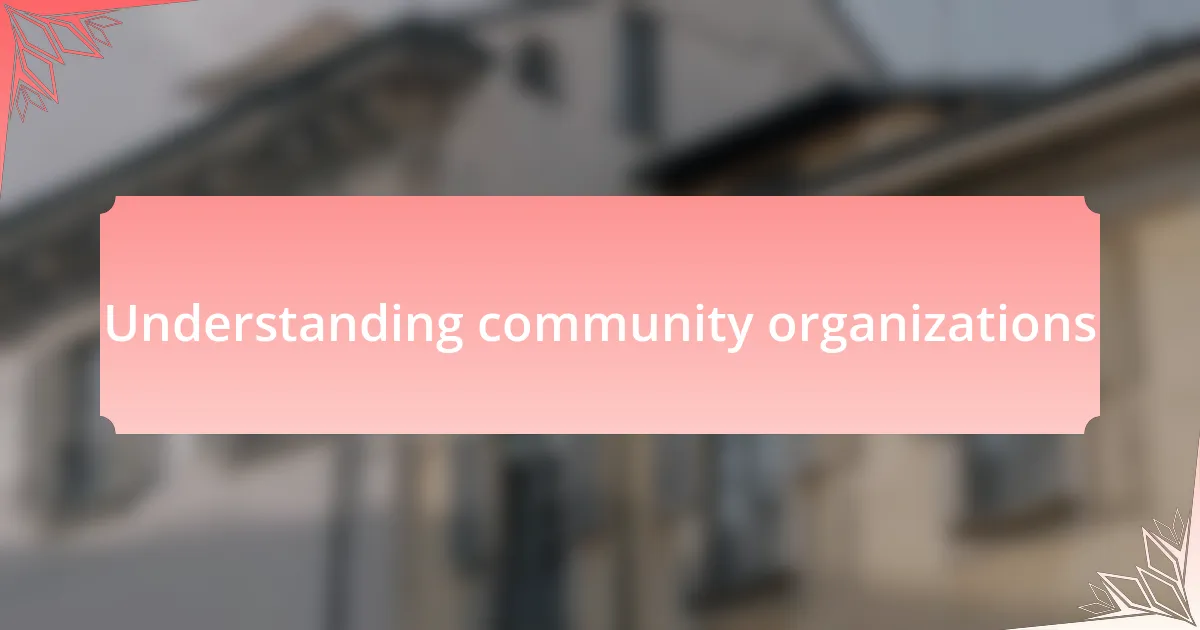
Understanding community organizations
Community organizations often serve as the backbone of local initiatives, bridging the gap between residents and the resources they need. I remember attending a neighborhood meeting where the energy was palpable; everyone had a voice and a shared purpose. This participatory atmosphere made me realize just how vital these organizations are in fostering collaboration and empowerment within a community.
What strikes me is how community organizations adapt to the unique needs of their neighborhoods. I once volunteered with a group focused on affordable housing solutions, and the diverse backgrounds of the members brought a wealth of perspectives to the table. Have you ever thought about how such collaborations can spark innovative solutions to common problems?
These organizations are more than just entities; they embody the spirit of the community. Reflecting on a time when I saw residents gather to clean up a local park, I felt a profound sense of connection among everyone involved. It became clear to me that the success of community organizations hinges on building relationships that foster trust and inclusivity.
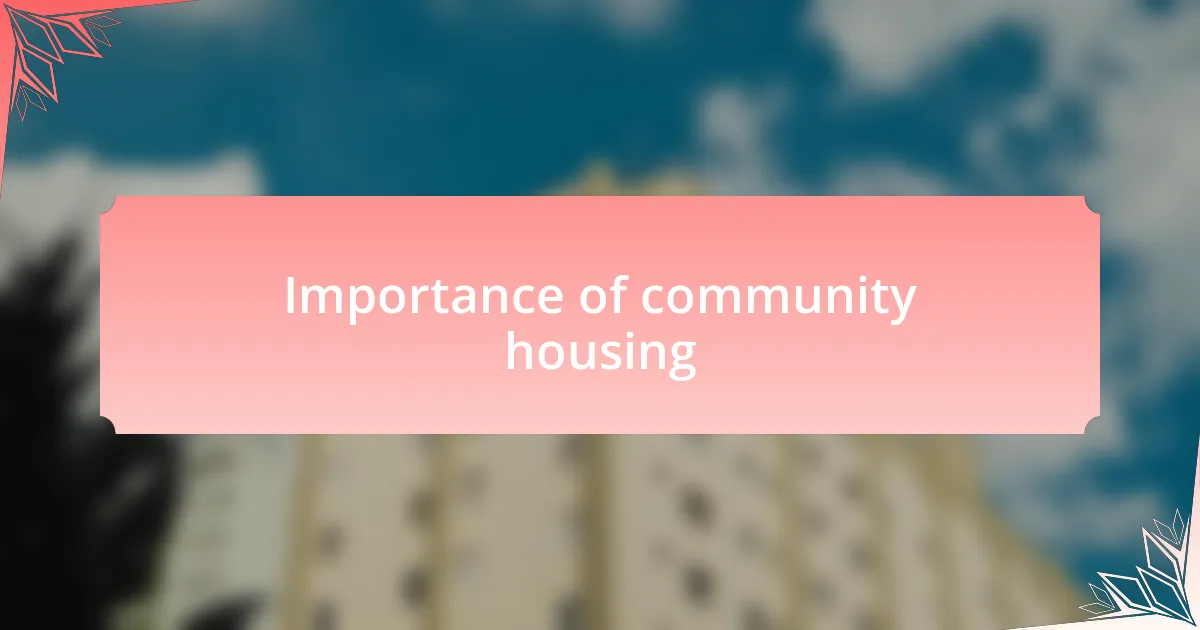
Importance of community housing
Community housing plays a crucial role in fostering stability within neighborhoods. I often think back to a time when I helped a family move into their new home, and the sense of relief and hope on their faces was incredibly moving. It reinforced for me how access to stable housing can transform lives, providing not just shelter but a sense of belonging and security.
Moreover, community housing initiatives bridge socioeconomic gaps, promoting diversity and social cohesion. I once attended an event where families from various backgrounds shared meals and stories in a new development. It struck me how such gatherings can break down barriers and create a sense of unity. Can you imagine how powerful it is when people come together, not just as neighbors but as a community?
The impact of community housing extends beyond individual families; it shapes the fabric of entire neighborhoods. While volunteering at a local shelter, I witnessed the ripple effect that stable housing can have on education and employment opportunities. It made me ponder how much stronger our communities could be if everyone had the opportunity to thrive in a nurturing environment.
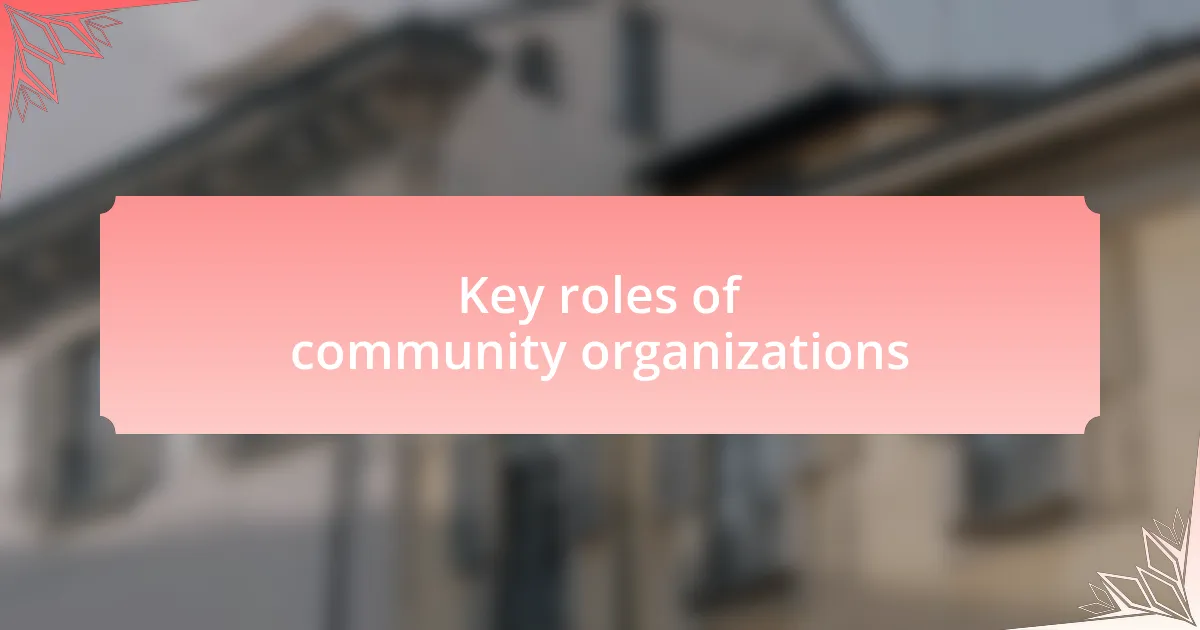
Key roles of community organizations
Community organizations serve as essential connectors in neighborhoods, facilitating cooperation among residents to address shared challenges. I remember attending a community meeting organized by a local nonprofit where residents voiced their concerns about public safety. The energy in the room was palpable, and I could see how gathering together motivated individuals to brainstorm practical solutions that ultimately fostered a stronger sense of security.
Another vital role of these organizations is advocacy. They champion the needs of vulnerable populations, ensuring that their voices are heard and considered in policy-making. I once participated in a campaign led by a community group that aimed to increase affordable housing options in our city. The passion and commitment of the volunteers were inspiring, and it made me realize how collective efforts can influence decision-makers and create tangible change in the community.
Lastly, community organizations often provide resources and education that empower residents. I’ve seen firsthand how workshops on financial literacy and home maintenance transformed individuals’ confidence and capabilities. Have you ever noticed how when people feel equipped, they are more likely to engage in improving their surroundings? It was heartening to witness neighbors sharing skills and knowledge, creating a ripple effect that uplifted the entire community.
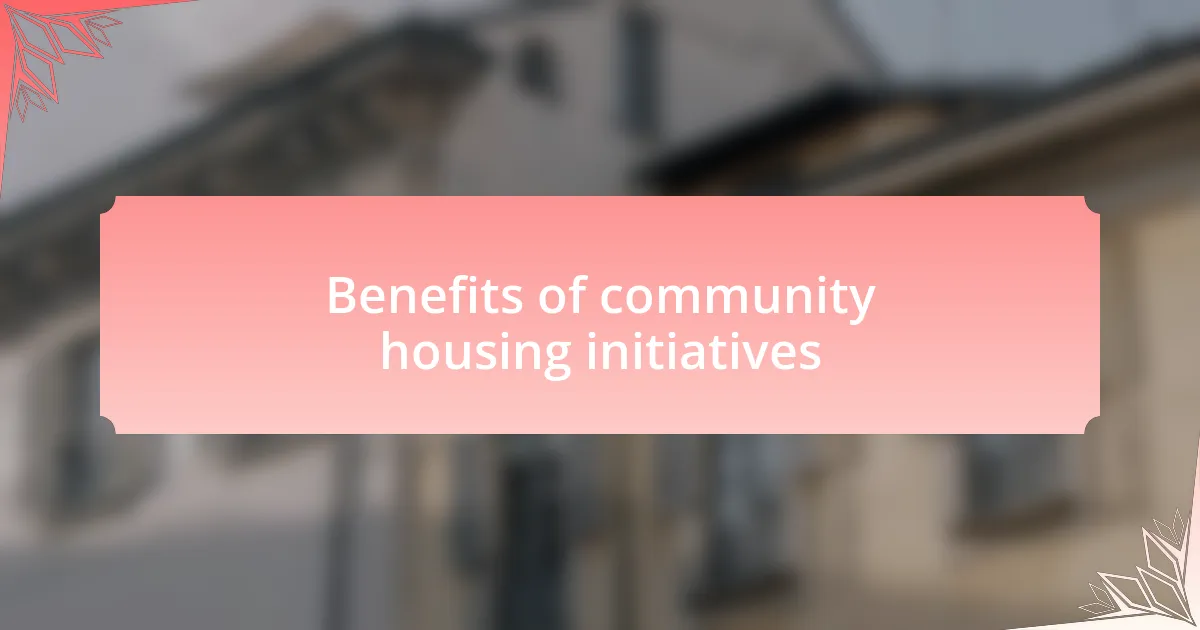
Benefits of community housing initiatives
Community housing initiatives offer a multitude of benefits that can significantly enhance the lives of residents. For instance, I once volunteered with a housing project that not only provided affordable homes but also fostered a real sense of community. Residents came together for potlucks and neighborhood clean-ups, leading me to realize how shared spaces can bolster relationships and encourage lasting friendships.
Additionally, these initiatives often promote economic stability within neighborhoods. I recall meeting a family that had struggled for years to afford rent; once they secured a home through a community initiative, their financial situation improved dramatically. Their story was a stark reminder of how stable housing can lead to better job performance and greater educational opportunities for children. Isn’t it fascinating how housing can serve as a foundation for broader economic growth?
Moreover, community housing initiatives address social equity by providing marginalized groups access to safe living conditions. I remember attending a workshop where someone shared their journey from homelessness to sustainable living. Listening to their experiences opened my eyes to the systemic barriers many face. It made me realize that when we support equitable housing efforts, we’re not just building houses; we’re cultivating hope and resilience within our communities.
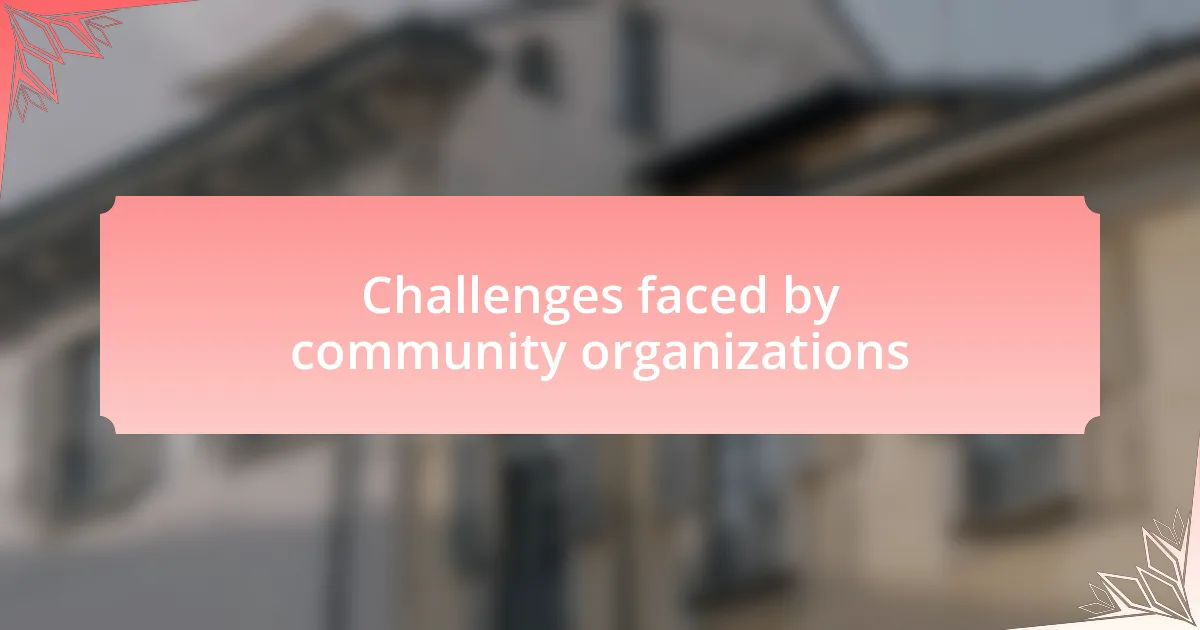
Challenges faced by community organizations
One of the significant challenges community organizations face is funding. I remember attending a fundraising event for a local housing project, and it struck me how difficult it was to secure consistent financial support. Relying on grants and donations often leads to uncertainty, which can hinder long-term planning and sustainability.
Another challenge is mobilizing volunteers. While volunteering can be incredibly rewarding, convincing people to commit their time and energy to a cause can be a struggle. During one outreach campaign, I encountered many individuals who were passionate but overwhelmed with their personal responsibilities. How can we truly engage a community if the very people we rely on are feeling stretched thin themselves?
Lastly, navigating bureaucratic processes often complicates the work of community organizations. I recall a project that was held up for months due to zoning regulations and permit approvals. This experience taught me how essential it is for organizations to not only advocate for their causes but also to understand the local political landscape. After all, how can change occur if the pathways to it are obstructed?
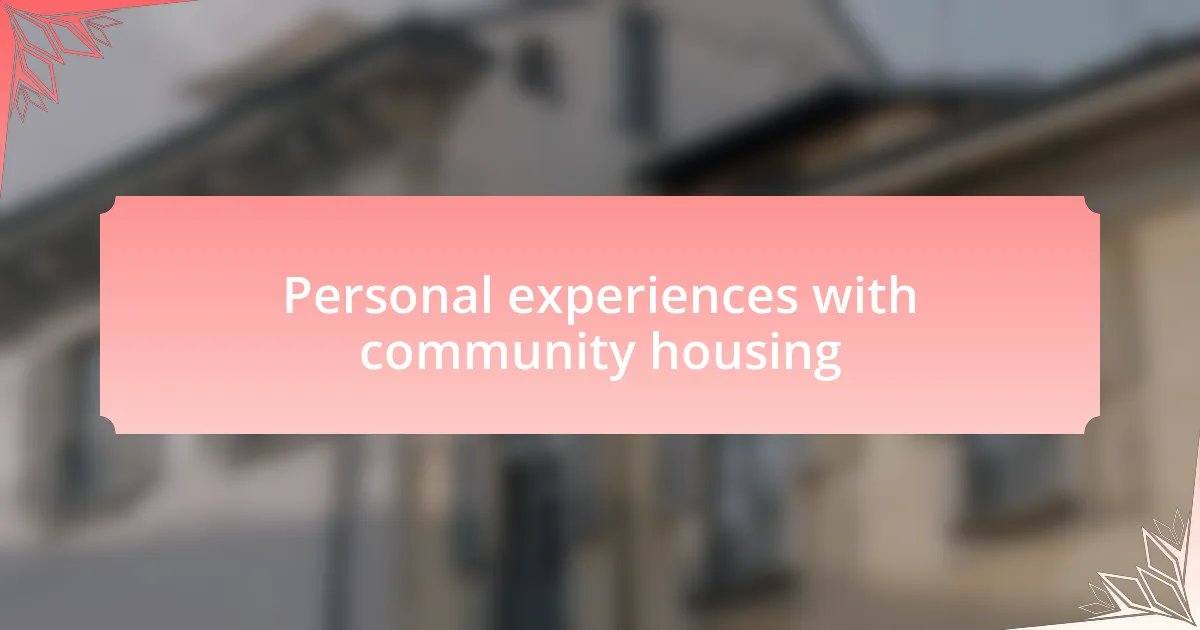
Personal experiences with community housing
I still remember my first encounter with a community housing initiative. It was a neighborhood meeting where residents shared their experiences and dreams for affordable homes. The passion in the room was palpable, but so was the frustration. It made me wonder: how can people with such strong connections feel so disconnected from the solutions they need?
Working alongside community organizations, I’ve often seen the transformative power of collective action. I once volunteered at a project that refurbished homes for families in need, and witnessing the joy on those families’ faces was truly moving. It reinforced my belief that community housing isn’t just about buildings; it’s about creating safe spaces for people to thrive.
There’s something deeply inspiring about the resilience I’ve seen in these organizations. During a particularly challenging winter, I helped distribute blankets and food to families living in temporary shelters. The strength and gratitude expressed by those individuals were reminders of the importance of connection and support. It makes me think, how can we continue to uplift each other in the face of such obstacles?
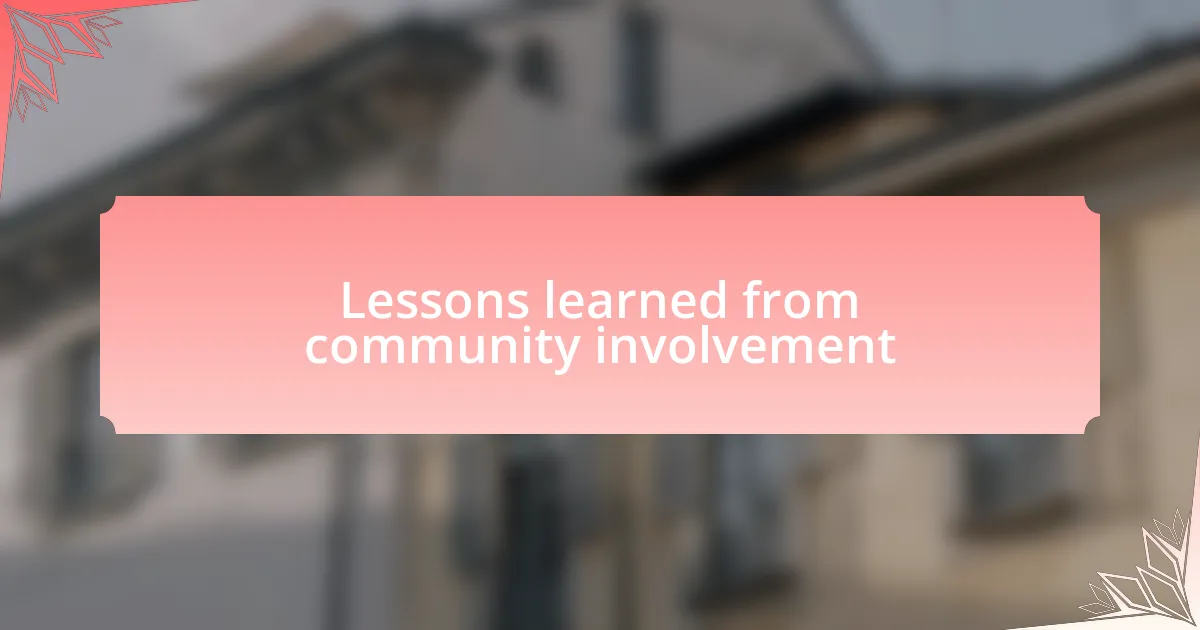
Lessons learned from community involvement
Engaging with community organizations has taught me that true change starts with listening. I recall a project where we gathered feedback from residents about their housing needs. Their stories illustrated the complexity of their situations, and it hit me: solutions can’t be imposed from above; they must emerge from within the community itself.
One of the most impactful lessons I’ve learned is the importance of trust and transparency. I remember a time when a proposed development faced resistance due to misinformation. It was through open dialogue—persistent communication and meeting residents on their turf—that we could clear up misunderstandings and build a foundation of trust. This experience reshaped my approach to community involvement; I now see these conversations not just as a necessity, but as a vital component of any successful initiative.
I’ve also come to appreciate the diverse strengths within a community. During one initiative, I partnered with local artisans to renovate a building. Their enthusiasm and unique skills brought a level of creativity that I hadn’t anticipated. It made me realize: when we truly harness the strengths of those around us, we can create spaces that reflect the community’s identity and aspirations. Isn’t that something worth striving for?